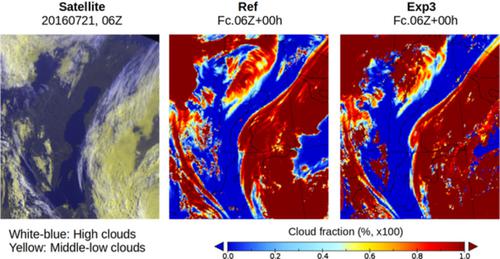当前位置:
X-MOL 学术
›
Meteorol. Appl.
›
论文详情
Our official English website, www.x-mol.net, welcomes your
feedback! (Note: you will need to create a separate account there.)
The use of satellite and surface observations for initializing clouds in the HARMONIE NWP model
Meteorological Applications ( IF 2.3 ) Pub Date : 2020-11-22 , DOI: 10.1002/met.1965 Erik Gregow 1 , Anders V. Lindfors 2 , Siebe H. van der Veen 3 , David Schoenach 1 , Siebren de Haan 3 , Magnus Lindskog 4
Meteorological Applications ( IF 2.3 ) Pub Date : 2020-11-22 , DOI: 10.1002/met.1965 Erik Gregow 1 , Anders V. Lindfors 2 , Siebe H. van der Veen 3 , David Schoenach 1 , Siebren de Haan 3 , Magnus Lindskog 4
Affiliation

|
The study tests and further develops a previously presented method for adjusting initial clouds in the HARMONIE mesoscale numerical weather prediction (NWP) model. The method uses satellite‐observed cloud properties from the Nowcasting and very short range forecasting Satellite Application Facility (NWCSAF) together with ground‐based synoptic stations (SYNOP) observations, adjusting the humidity profile of the model based on the available cloud information with the overall aim to improve the forecast, in particular as regards clouds and solar radiation. A reference set‐up of the HARMONIE model is used as a baseline against which the cloud initialization experiments are compared. All HARMONIE experiments are run for July 2016, with a model run starting at 06Z each day. The HARMONIE outputs are compared with cloud fraction and solar radiation observations from ground‐based stations, while satellite cloud observations are also used for inspecting the behaviour of the forecasts. The performance of other generally used verification parameters is also studied. The results as regards clouds are encouraging. Symmetrical extremal dependence index (SEDI) skill scores show improvement in initial cloud conditions in 84% and 74% of the cases, when evaluated for cloud‐free (0–1 octas) and cloudy conditions (7–8 octas), respectively. The improvement lasts 2–4 hr into the forecast. Other parameters, however, show somewhat degraded skill as compared with the reference model run, while for solar radiation, the cloud initialization scheme exhibits somewhat ambiguous results. The distribution of solar radiation values is improved for relatively sunny conditions, while at the other end of the distribution, the cloud initialization scheme produces too many cases with relatively strongly attenuated radiation.
中文翻译:

在HARMONIE NWP模型中使用卫星和地面观测来初始化云
该研究测试并进一步开发了先前介绍的用于在HARMONIE中尺度数值天气预报(NWP)模型中调整初始云的方法。该方法结合了临近预报和极短距离预报卫星应用设施(NWCSAF)的卫星观测云特性以及地面天气观测站(SYNOP)观测结果,并根据可用云信息和整体观测结果调整了模型的湿度分布旨在改善预报,尤其是关于云和太阳辐射的预报。HARMONIE模型的参考设置用作比较云初始化实验的基准。所有HARMONIE实验均于2016年7月进行,每天运行的模型从06Z开始。将HARMONIE的输出与来自地面站的云层分数和太阳辐射观测值进行比较,同时还将卫星云云观测值用于检查预测的行为。还研究了其他常用验证参数的性能。关于云的结果令人鼓舞。对称极值依赖指数(SEDI)技能评分显示,分别针对无云(0–1 octa)和阴天(7–8 octa)进行评估时,初始云条件下有84%和74%的情况有所改善。改善持续了2-4小时。但是,与参考模型运行相比,其他参数显示的技能有所下降,而对于太阳辐射,云初始化方案显示出的结果有些模糊。
更新日期:2020-11-22
中文翻译:

在HARMONIE NWP模型中使用卫星和地面观测来初始化云
该研究测试并进一步开发了先前介绍的用于在HARMONIE中尺度数值天气预报(NWP)模型中调整初始云的方法。该方法结合了临近预报和极短距离预报卫星应用设施(NWCSAF)的卫星观测云特性以及地面天气观测站(SYNOP)观测结果,并根据可用云信息和整体观测结果调整了模型的湿度分布旨在改善预报,尤其是关于云和太阳辐射的预报。HARMONIE模型的参考设置用作比较云初始化实验的基准。所有HARMONIE实验均于2016年7月进行,每天运行的模型从06Z开始。将HARMONIE的输出与来自地面站的云层分数和太阳辐射观测值进行比较,同时还将卫星云云观测值用于检查预测的行为。还研究了其他常用验证参数的性能。关于云的结果令人鼓舞。对称极值依赖指数(SEDI)技能评分显示,分别针对无云(0–1 octa)和阴天(7–8 octa)进行评估时,初始云条件下有84%和74%的情况有所改善。改善持续了2-4小时。但是,与参考模型运行相比,其他参数显示的技能有所下降,而对于太阳辐射,云初始化方案显示出的结果有些模糊。











































 京公网安备 11010802027423号
京公网安备 11010802027423号